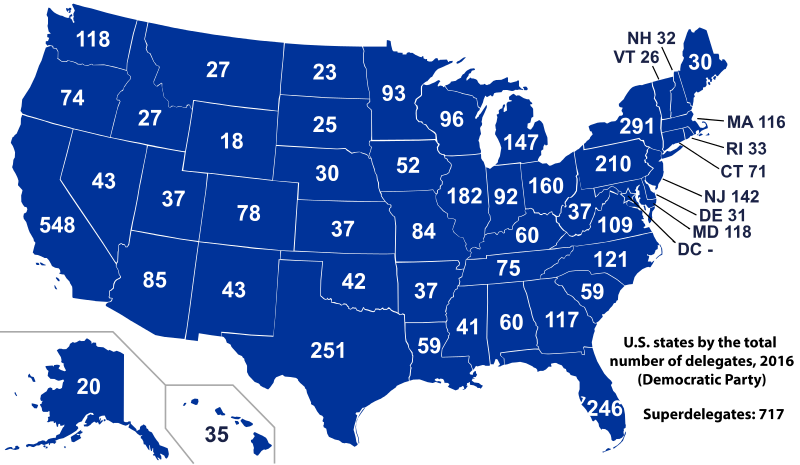
States by Democratic primary delegate count. Note that some territories with binding delegates have been omitted.
We need to talk about the Democratic nomination process.
Last night, the Associated Press and many other outlets made the call to announce that Hillary Clinton is the “presumptive nominee” for president by the Democrats.
This was bad, unethical journalism even though Clinton is in all likelihood going to become the presumptive nominee by next week. However, “going to become” and “is” are two different things. (More on that from Paste.)
At the same time, yesterday social media influencers (primarily Sanders supporters) released an image of “Real Math” that seems to disprove that anyone can become the presumptive nominee before the Democratic National Convention on July 25th. This image doesn’t include the context of factors affecting said math. It is intentionally misleading in an effort to rile up Sanders supporters and Clinton foes.
From my perspective, it seems that three things are presently objectively true, with a fourth that is subjectively true for me. I am summarizing them below not to change your mind, but to try to engage transparently and reasonably with the information that’s available to me right now. I urge you to look at whole picture, and not solely what any single biased source (me included) may or may not be reporting.
Here we go!
1. The media irresponsibly called the presumptive nominee last night just 12 hours before the last major set of delegates are voted upon.
Let me explain how the Associated Press acted unethically. Their methodology to arrive at said early call involved the author of the piece calling superdelegates and asked them if they really, really, really planned to vote for Clinton at the convention. That’s not good journalism – or, at least, not any better than using the endorsement information already publicly available. They actually fabricated news to get in front of a news cycle.
They should have waited until this evening, at least to make that call. Why this evening?
First, because it is manipulative to release such an announcement on the eve of a critical vote when it isn’t entirely accurate. It has the potential to suppress the vote for both candidates, affecting downticket contests. The AP and major networks could have restrained themselves for 24hrs.
Second, because I feel it would be fair to call a presumptive nominee who is leading in pledged delegates and who would reach the nomination threshold if superdelegates voted proportionally to their constituents to express the will of their constituents (even though superdelegates don’t actually behave that way). It is likely that after today one of the two remaining candidates will reach that threshold.
2. To become the nominee, a candidate needs a minimum of 2,383 delegates at the convention.Presently, based on the primary process and not including superdelegates, Clinton is at 1,811 pledged delegates (she needs 511) while Sanders is at 1,526 pledged delegates (he needs 857). [Source: 538]
A total of 694 delegates are at stake today and 20 next week in DC. That’s 714 delegates. To clinch the nomination next week, Clinton would need to win with 80% in these contests.To tie Clinton, Sanders would need to win with 70% in these contests. (That’s a generalization, since the pledged delegate rules in each contest are not strictly proportional to the vote, but it’s close enough to the case for this discussion).
Neither of those things are likely to happen. To clinch the nomination, each candidate would need some amount of 715 super-delegates – 15% of total available delegates. You should learn more about who they are, but in brief: they are elected Democrats and party officials and they can change their minds (and their pledges) as often as they like up until the first floor vote at the Democratic National Convention in my proud city of Philadelphia on July 25.
3. Assuming these remaining primaries result closer to 50/50 than 70/30, Sanders would need a disproportionate amount of 715 superdelegates to support him compared to his performance in their states to become the nominee.
This ignores that superdelegates don’t actually behave that way – they are gut-check votes from within the party that are meant to slightly “fix” the system by giving party members 15% of the power in the nomination system. They can vote however they’d like.
Yet, voting proportionally to their constituents would be a reasonable way for them to behave in a fair, un-fixed system during a hotly contested primary. They would need to correspondingly make an unreasonable or unfair determination as a group that did not reflect the votes and delegates in the primary/caucus system in order for Sanders to become the nominee.
4. Based on my personal idea of a fair call of the presumptive nominee expressed above, if Clinton does better than 30% in votes today and next week’s vote, I feel it would be appropriate to call her as the presumptive nominee – understanding that anything can happen at the convention. That’s why we use the word “presumptive.”
##
I encourage you to not take my word for this, but to use it as a jumping-off point to research and under this information yourself. If working from this same information, you can see a way for Sanders to become the presumptive nominee – or for there to be a good reason not to name a presumptive nominee – I am all ears.